Mumbai-based transport experts pen open letter to railway minister Ashwini Vaishnaw
In an open letter, Mumbai Mobility Forum, a transport think tank based in Mumbai has suggested Railway Minister Ashwini Vaishnaw to electrify and introduce more and longer trains and reducing the time between two trains, particularly goods trains.
Presenting a comparative analysis, economist and transport analyst Ashok Datar along with electrical engineer and civic activist A.V. Shenoy, who are founder members of the policy-oriented think tank that analyses Mumbai’s transportation issues from citizens’ perspective and suggest solutions, thank the railway minister for reducing AC train fares. The experts have urged Vaishnaw to build railway tracks with the speed of highways, demonstrating that it is economical and environment friendly to have more trains than highways.
“The British built railway tracks with much higher speed 150 years back than today. In India in 1947, railways carried about 80% of total traffic, whereas now the situation is reverse. Though roads can reach remote corners and can be used by cars, trucks, buses and even two wheelers, there are distinct benefits of railways. With electrification trains can be 2 to 3 times faster, 6 times more fuel efficient and virtually emission free,” says the letter.
Railways have also been main movers of coal for thermal plants and have been able to help government for mass movement of water by tanker trains during draughts and liquid oxygen for medical purpose during Covid pandemic.
All these years Railways have concentrated only on gauge conversion, track duplication and electrification but not on addition of tracks. Except Konkan Railway and Jammu Srinagar Railway no major lines have been added since independence.
It says that in the pre-information technology age, railway wagons would get lost in a maze at junctions and ports and despite costly fuel, people preferred travelling by road and door-to-door delivery by trucks as it saved a lot of time. As cars became technologically advanced, cheaper and mass-produced, private cars came to be the dominant users of roads, relegating buses to secondary status.
On buses, the letter says that as compared to cars and trains there have been meagre improvements in the buses so far, even as things are slowly changing in this regard. Now we have high-speed 100-seater double-decker comfortable AC buses at a lower cost that save time.
Infrastructure conjures up an image of highways like in America, with multiple lanes and flyovers in cities as well as long distance highways where one can drive hundreds of miles with barely a signal or two. We often wonder whether we have gone too far.
“Our love for highways has made us blind to an objective understanding or specific merits and demerits of railways and roads. Both stand strong on points in their favour,” it says.
In the US and China, railways continue to dominate goods traffic; especially to ports and back. Now information technology is helping us track buses and trucks. This weakness of railways too has been considerably improved now even as there is a scope for further improvement. “We have lost track of cost/km for highways and railways under operation. We have also lost track of operating cost (especially the fossil fuels) where railways are far superior and cheaper. We need to know ‘this number’ by heart,” says the letter to Vaishnaw.
Making a strong case for electrification of railways to reduce costs, time and emissions, the letter says, “Today, railways are cheaper than roadways in fuel cost /km by approximately 6 times. This needs to be scientifically worked out and compared with that of electric traction. And if this is wrong it is sheer apathy of lack of basic research. With growth in volumes, costs and benefits of both systems need to be appropriately and seriously understood and compared. When the cost of electricity is low as compared to diesel, for optimum results, cost of electrification must be allocated to larger number of trains that use the track every day. We need to undertake and improve several measures including use of more and longer trains particularly goods trains reducing time between two trains.”
Illustrating with the sample of a few completed and current projects under consideration in view of an increase of cost of raw materials like cement, steel, road building materials like stone crush, etc over the period of years, the experts say, “It is commonly believed that road costs are cheaper than railways. But looking at the following information on roads and rail lines, the reverse seems to be true. Railways are typically a two- line configuration whereas modern highways are minimum 3+3 lanes.”
Cost /km of highways
From – To |
Start yr |
Km |
Lanes |
Cost- Rs Cr |
Cost /kmCr |
| Mumbai-Pune |
2002 |
95 |
6 |
1600 |
17 |
| Nagpur –Mumbai |
2024 |
701 |
8 |
55000 |
78 |
| Mumbai-Delhi |
2023 |
1380 |
8 |
98233 |
71 |
| Sewri-Nhava Shewa |
2024 |
21.8 |
6 |
17843 |
818 |
| Bandra-Worli sea link |
2009 |
6.8 |
4 |
1600 |
235 |
| Eastern freeway |
2012 |
11 |
4 |
1500 |
136 |
| Coastal Road MumbaI |
2025 |
10.7 |
8 |
14000 |
1308 |
| Thane –Borivali |
2026 |
11 |
6 |
10000 |
909 |
Cost of three special rail corridors (per km)
From - To |
Start yr |
Km |
Lanes |
Cost- Rs Cr |
Cost /km Cr |
Comments |
| Pune-Nashik |
2022 |
235 |
2 |
16039 |
68 |
Semi hi speed – |
| Ludhiana -Mumbai(WFC) |
2024 |
1500 |
2 |
95000 |
78 |
Dedicated freight corridor |
| Ahm – Mumbai |
2018 |
501 |
2 |
120,000 |
240 |
Bullet train |
“There is obvious and huge variation between rail and road cost/km which cannot be explained by a formula based on inflation. We study this by having a wider sample of major national highways to see the extent of responsible cost of land (this applies to railways also). We are not opposed to cars as such but that should not be the implicit reason to justify having roads without considering other parameters. We must make wise choices considering all factors including shortage of space and need to reduce emissions at least by 80% by 2050 below 1990 levels. Is that possible with road centric highway policy? Think of our children and grandchildren,” the experts write.

